|
Größe: 3246
Kommentar:
|
Größe: 6308
Kommentar:
|
| Gelöschter Text ist auf diese Art markiert. | Hinzugefügter Text ist auf diese Art markiert. |
| Zeile 8: | Zeile 8: |
| * R is designed for text based interactions, the full functionality is not available through menues | * R is designed for text based interactions, the full functionality is not available through menus |
| Zeile 19: | Zeile 19: |
| * After you have installed deducer, you have to load the Deducer related packages (this extends the menues) * go to the ''packages & data'' menue in the menue bar |
* After you have installed deducer, you have to load the Deducer related packages (this extends the menus) * go to the ''packages & data'' menu in the menu bar |
| Zeile 31: | Zeile 31: |
| * Now basic statistical procedures are available through the menues (and from now on in every session) | * Now basic statistical procedures are available through the menus (and from now on in every session) |
| Zeile 36: | Zeile 36: |
| * go to the ''Extras'' menue in the menue bar and choose ''Load data from package'' | * go to the ''Extras'' menu in the menu bar and choose ''Load data from package'' |
| Zeile 42: | Zeile 42: |
| == Open the Data Viewer == The data viewer provides an easy to use, spreadsheet-like environment to view and edit data. Copy and pasting is supported, and is compatible with Excel 2003/2007, so data can be moved from Excel to R by simply copying it to the data viewer. Contextual menus are used to insert, delete and copy rows and columns. {{attachment:dataviewer1.png|alt text|width=600}} == The Data Viewer - Data View == {{attachment:dataviewer2.png|alt text|width=600}} * a right click on the row or column headers * allows one to insert, copy and delete columns and rows \note{Add column sex} * sort by one column * you can also edit the data * in the drop down menu Data Set you can choose the data frame {{attachment:dataviewer4.png|alt text|width=600}} == The Data Viewer - Variable View == {{attachment:dataviewer3.png|alt text|width=600}} In the variable view The variable column represents the variable name. The type column determines the storage type. * the properties of each variable in the data frame can be edited * the type column determines the storage type; variables can be stored as * Strings (character) * Doubles (Numeric) * Integers * Logicals (yes/no) or * Factors * The levels of Factors are displayed in the 'Factor Levels' column, and can be edited by clicking on the appropriate cell, which brings up the Factor Editor The levels of Factors are displayed in the 'Factor Levels' column, and can be edited by clicking on the appropriate cell, which brings up the Factor Editor. {{attachment:dataviewer5.png|alt text|width=600}} === Exercise === 1. Find and load the MASS package (via the ''Packages & Data'' menu). 2. Load the Pima.te data (if you haven't done it already) |
|
| Zeile 44: | Zeile 77: |
| == Some Basic Descriptives == === Tables === * now go to the ''Analysis'' menu from the menu bar and choose ''Frequencies'' * a little window will show up, make sure that in the upper left corner you have chosen the ''Pima.te'' data set {{attachment:frequded1.png|alt text|width=600}} * the left half of the window shows all available variables * choose ''npreg'' (number of pregnancies) and ''type'' and transfer them to the righthandside * now click the ''ok'' button * what we get is a table containing the absolute frequencies, the relative frequencies and the cumulative frequencies |
|
| Zeile 45: | Zeile 87: |
| === Exercise === 1. Find and load the MASS package. |
=== Numeric Summaries === * now go to the ''Analysis'' menu from the menu bar and choose ''Descriptives'' * again a little window will show up, make sure that in the upper left corner you have chosen the ''Pima.te'' data set {{attachment:descrded1.png|alt text|width=600}} * the left half of the window shows all available variables * choose ''bmi'' {{attachment:descrded2.png|alt text|width=600}} * now click the ''ok'' button * now we get a window where you can choose the summary statistics you are interested in * you may choose the mean, the standard deviation, and the number of valid n {{attachment:descrded3.png|alt text|width=600}} * press the run button and you get the results |
About Deducer
Why Deducer?
Deducer is designed to be a free easy-to-use alternative to proprietary data analysis software such as SPSS, JMP, and Minitab. It has a menu system to perform common data manipulation and analysis tasks, and an excel-like spreadsheet in which to view and edit data frames. The goal of the project is two fold.
- Provide an intuitive graphical user interface (GUI) for R, encouraging non-technical users to learn and perform analyses without programming getting in their way. So it may lower the entry threshold.
- Increase the efficiency of expert R users when performing common tasks by replacing hundreds of keystrokes with a few mouse clicks. Also, as much as possible the GUI should not get in their way if they just want to do some programming.
Why Not?
- Deducer is java-dependend and therefore sometimes not stable (although it has been a long time since I had problems, but I work very rarely with the deducer package; maybe it is more stable these days)
- R is designed for text based interactions, the full functionality is not available through menus
- the course will be based on typing the commands but maybe the Deducer GUI helps to overcome your inhibition to use R
Installation
there are instructions how to install at http://www.deducer.org/
- from within R:
- run R
- type library(JGR)
- followed by JGR()
- there is also a script created during the installation; the path is shown when you start Deducer via R (e.g. \texttt{~/R/i686-pc-linux-gnu-library/2.14/JGR/scripts/run}
Prepare
- After you have installed deducer, you have to load the Deducer related packages (this extends the menus)
go to the packages & data menu in the menu bar

choose Package Manager
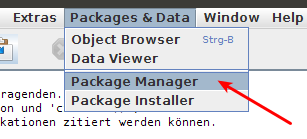
- the package manager opens up:
by marking the checkboxes in the first column you can load packages (loaded)
by marking the ckeckboxes in the second column you can choose which packages you want to be automatically loaded every time you start Deducer (default)
- the third and fourth columns show the name and a short description of the packages respectively
scroll down to the Deducer and the DeducerExtra packages and mark for each of them both: the loaded and the default checkbox
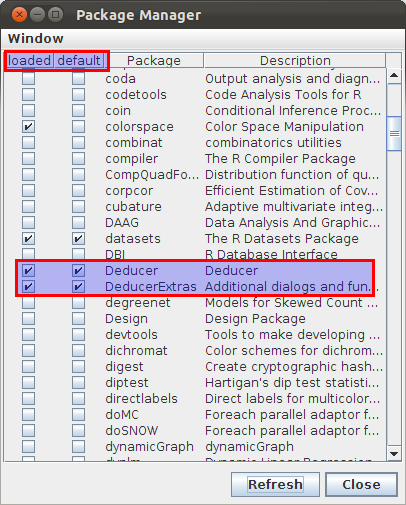
close the package manager by clicking on the Close button
- Now basic statistical procedures are available through the menus (and from now on in every session)
First Steps
- now we will test some functionalities
- so first we load an examples data set:
go to the Extras menu in the menu bar and choose Load data from package
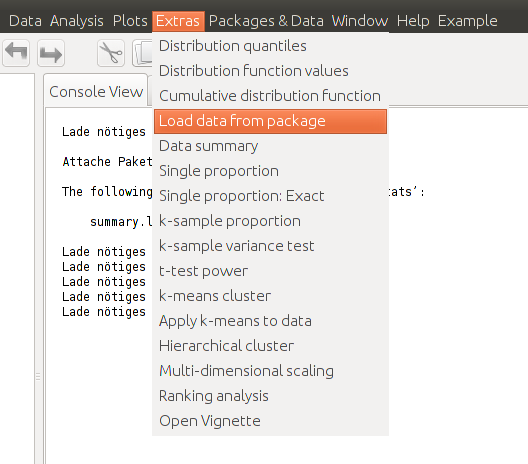
- a little window opens up and you can choose a data set
for now choose the Pima.te data set and click the Run button
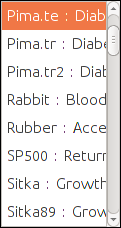
Open the Data Viewer
The data viewer provides an easy to use, spreadsheet-like environment to view and edit data. Copy and pasting is supported, and is compatible with Excel 2003/2007, so data can be moved from Excel to R by simply copying it to the data viewer. Contextual menus are used to insert, delete and copy rows and columns.
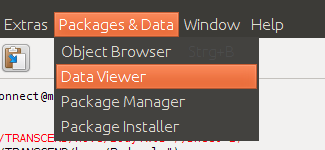
The Data Viewer - Data View
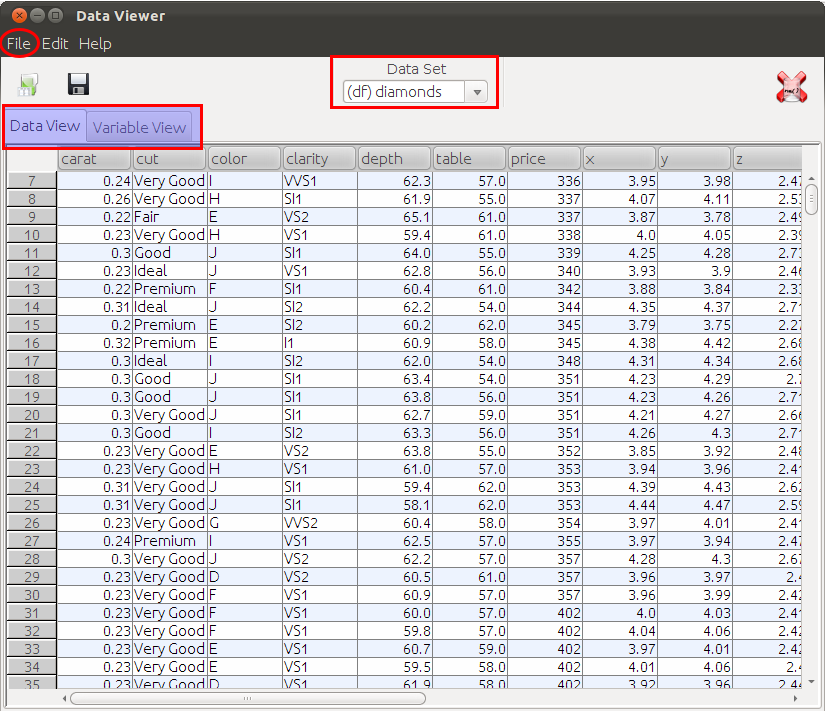
- a right click on the row or column headers
- allows one to insert, copy and delete columns and rows \note{Add column sex}
- sort by one column
- you can also edit the data
- in the drop down menu Data Set you can choose the data frame
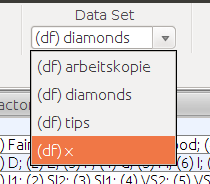
The Data Viewer - Variable View
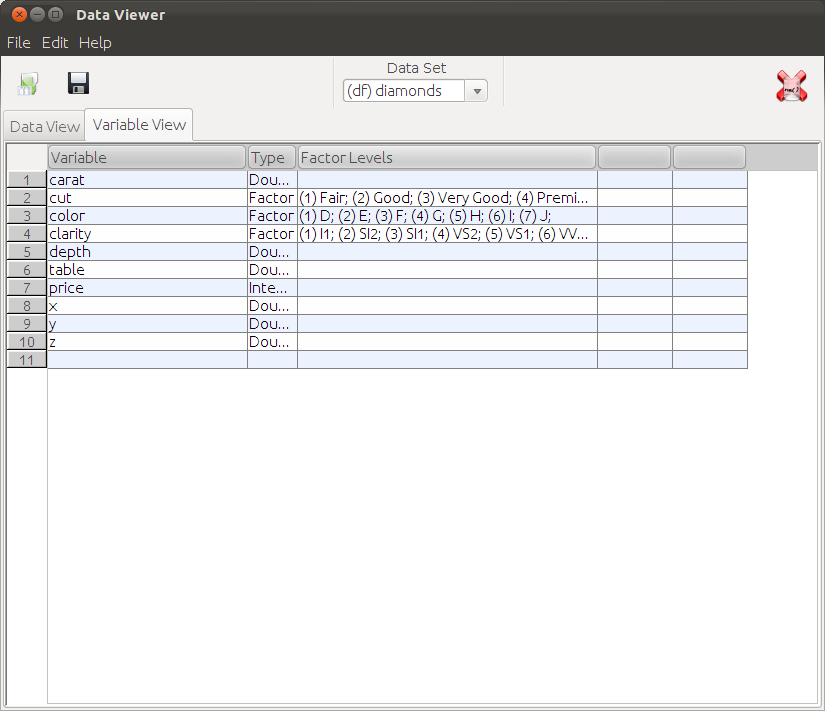
In the variable view The variable column represents the variable name. The type column determines the storage type.
- the properties of each variable in the data frame can be edited
- the type column determines the storage type; variables can be stored as
- Strings (character)
- Doubles (Numeric)
- Integers
- Logicals (yes/no) or
- Factors
- The levels of Factors are displayed in the 'Factor Levels' column, and can be edited by clicking on the appropriate cell, which brings up the Factor Editor
The levels of Factors are displayed in the 'Factor Levels' column, and can be edited by clicking on the appropriate cell, which brings up the Factor Editor.
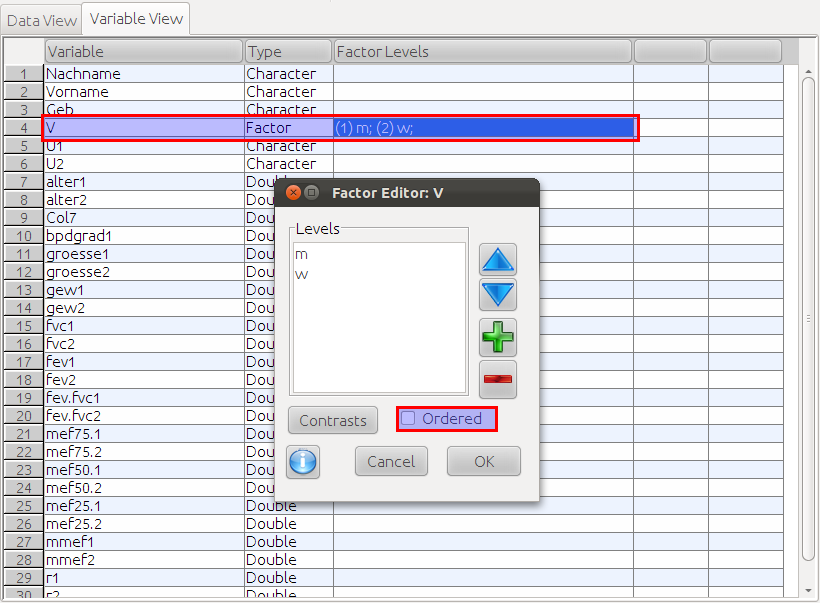
Exercise
Find and load the MASS package (via the Packages & Data menu).
- Load the Pima.te data (if you haven't done it already)
Some Basic Descriptives
Tables
now go to the Analysis menu from the menu bar and choose Frequencies
a little window will show up, make sure that in the upper left corner you have chosen the Pima.te data set
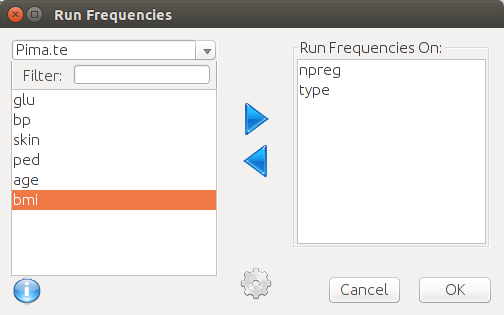
- the left half of the window shows all available variables
choose npreg (number of pregnancies) and type and transfer them to the righthandside
now click the ok button
- what we get is a table containing the absolute frequencies, the relative frequencies and the cumulative frequencies
Numeric Summaries
now go to the Analysis menu from the menu bar and choose Descriptives
again a little window will show up, make sure that in the upper left corner you have chosen the Pima.te data set
- the left half of the window shows all available variables
choose bmi
now click the ok button
- now we get a window where you can choose the summary statistics you are interested in
- you may choose the mean, the standard deviation, and the number of valid n
- press the run button and you get the results
